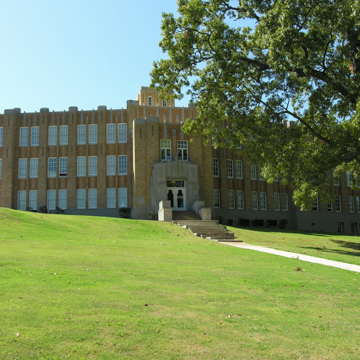Although planned for three stories, this Art Deco brick and stone former hospital was built in 1937 with just two. The third was added in 1949 along with a two-bay-wide addition to the building’s west end in order to accommodate the need for more facilities. The building, monumentally sited on a hill, has a butterfly-wing-shaped plan, and at its center the entrance is emphasized in stone with bold pilasters and stylized ornamentation. Brick pilasters separate the banks of windows, and rising above the roofline they give the building a mildly castellated flavor. At the rear of the building are semicircular balconies with railings, a nautical imagery that was popular in the 1930s and, more practically, gave spaces where patients could sit in the fresh air. This building replaced a Colonial Revival house that served as the first hospital. It was operated by the Benedictine nursing sisters of St. Scholastica Convent (SB15) in Fort Smith, who also served this new building. Although designed in 1935, construction began only in 1937 when the necessary funding was obtained. Initially, it was intended that the PWA would fund construction, but because a religious organization was involved, federal funding fell through, and the City raised the money instead. Although the hospital was equipped with the most modern facilities when built, by 1970 they had become outdated, and the hospital closed. In the 1980s, the building was converted to affordable apartments for seniors.
You are here
St. Anthony’s Apartments (St. Anthony’s Hospital)
If SAH Archipedia has been useful to you, please consider supporting it.
SAH Archipedia tells the story of the United States through its buildings, landscapes, and cities. This freely available resource empowers the public with authoritative knowledge that deepens their understanding and appreciation of the built environment. But the Society of Architectural Historians, which created SAH Archipedia with University of Virginia Press, needs your support to maintain the high-caliber research, writing, photography, cartography, editing, design, and programming that make SAH Archipedia a trusted online resource available to all who value the history of place, heritage tourism, and learning.





















